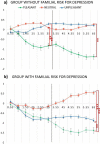Familial risk for depression is associated with reduced P300 and late positive potential to affective stimuli and prolonged cardiac deceleration to unpleasant stimuli
- PMID: 37081143
- PMCID: PMC10119159
- DOI: 10.1038/s41598-023-33534-z
Familial risk for depression is associated with reduced P300 and late positive potential to affective stimuli and prolonged cardiac deceleration to unpleasant stimuli
Abstract
Despite evidence of abnormal affective processing as a key correlate of depression, specific attentional mechanisms underlying processing of emotions in familial risk for depression have yet to be investigated in a single study. To this end, the amplitude of the P300 and late positive potential (LPP) complex and cardiac deceleration were assessed during the passive viewing of affective pictures in 32 individuals who had family history of depression (without depressive symptoms) and in 30 controls (without depressive symptoms and family history of depression). Individuals with familial risk for depression revealed reduced P300-LPP amplitudes in response to pleasant and unpleasant stimuli relative to controls, and comparable P300-LPP amplitudes in response to pleasant and neutral stimuli. Controls, but not individuals with familial risk for depression, reported cardiac deceleration during the viewing of pleasant vs. neutral and unpleasant stimuli in the 0-3 s time window. Also, only individuals with familial risk for depression showed a prolonged cardiac deceleration in response to unpleasant vs. neutral stimuli. Overall, the present study provides new insights into the characterization of emotion-related attentional processes in familial risk for depression as potential vulnerability factors for the development of the disorder.
© 2023. The Author(s).
Conflict of interest statement
The authors declare no competing interests.
Figures




Similar articles
-
Disentangling emotional processing in dysphoria: An ERP and cardiac deceleration study.Behav Res Ther. 2021 Dec;147:103985. doi: 10.1016/j.brat.2021.103985. Epub 2021 Oct 7. Behav Res Ther. 2021. PMID: 34628258
-
The late positive potential during affective picture processing: Associations with daily life emotional functioning among adolescents with anxiety disorders.Int J Psychophysiol. 2022 Dec;182:70-80. doi: 10.1016/j.ijpsycho.2022.09.009. Epub 2022 Sep 27. Int J Psychophysiol. 2022. PMID: 36174791 Free PMC article.
-
Attention and affect in dysphoria: Insights from startle reflex modulation and cardiac deceleration.Behav Res Ther. 2020 Aug;131:103626. doi: 10.1016/j.brat.2020.103626. Epub 2020 Apr 28. Behav Res Ther. 2020. PMID: 32387705
-
Significance?& Significance! Empirical, methodological, and theoretical connections between the late positive potential and P300 as neural responses to stimulus significance: An integrative review.Psychophysiology. 2020 Jul;57(7):e13570. doi: 10.1111/psyp.13570. Epub 2020 Apr 3. Psychophysiology. 2020. PMID: 32243623 Review.
-
Abnormalities of the late positive potential during emotional processing in individuals with psychopathic traits: a meta-analysis.Psychol Med. 2020 Sep;50(12):2085-2095. doi: 10.1017/S0033291719002216. Epub 2019 Sep 3. Psychol Med. 2020. PMID: 31477196
Cited by
-
Familial risk for depression is associated with reduced physical activity in young adults: evidence from a wrist-worn actigraphy study.Transl Psychiatry. 2024 May 28;14(1):219. doi: 10.1038/s41398-024-02925-9. Transl Psychiatry. 2024. PMID: 38806490 Free PMC article.
-
Adverse childhood experiences and internalizing symptoms: the moderating role of neural responses to threat.Neurobiol Stress. 2025 Jun 10;37:100740. doi: 10.1016/j.ynstr.2025.100740. eCollection 2025 Jul. Neurobiol Stress. 2025. PMID: 40585905 Free PMC article.
-
Reduced approach disposition in familial risk for depression: Evidence from time-frequency alpha asymmetries.PLoS One. 2024 Jul 24;19(7):e0307524. doi: 10.1371/journal.pone.0307524. eCollection 2024. PLoS One. 2024. PMID: 39047003 Free PMC article.
-
Differences in cognitive deficits and brain functional impairments between patients with first-episode and recurrent depression.BMC Psychiatry. 2025 Apr 29;25(1):434. doi: 10.1186/s12888-025-06758-8. BMC Psychiatry. 2025. PMID: 40301743 Free PMC article.
References
-
- Institute of Health Metrics and Evaluation. Global Health Data Exchange (GHDx). http://ghdx.healthdata.org/gbd-results-tool?params=gbd-api-2019-permalin... (2021).
Publication types
MeSH terms
Substances
LinkOut - more resources
Full Text Sources
Medical
Miscellaneous

